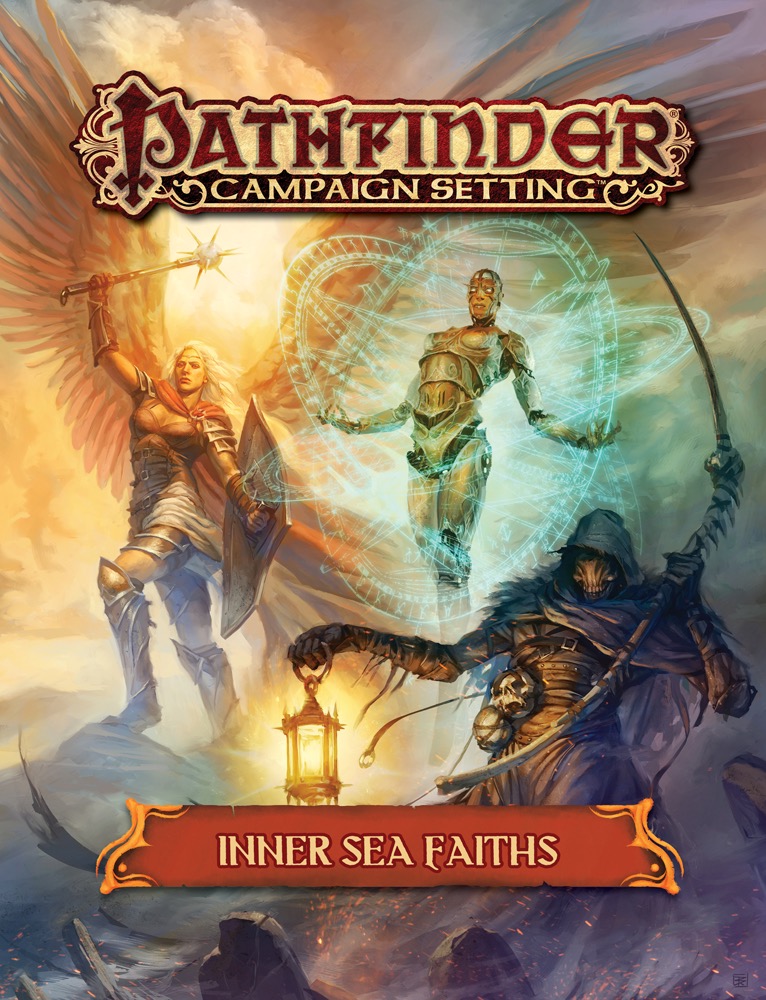Clerics
have always been one of my favourite classes. I like getting into the
mindset of people who devote their lives to serving greater powers.
As such, I also love books that focus on those powers—what their
religions are like and what drives their followers. One of the
most-used Pathfinder books in my games (apart from the central
rulebooks) is Inner Sea Gods,
which provides detailed information on the core 20 gods of the
Golarion setting (along with additional character options).
However,
Golarion has considerably more than just 20 gods. Inner Sea
Gods contains details on many of
the others, but no book has unlimited space, so these additional
details are understandably brief—half a page at most, and often no
more than a single paragraph. Some
of these additional gods have received more detailed write-ups in
other sources, such as volumes of Pathfinder Adventure
Path, but ever since Inner
Sea Gods came out, I’ve hoped
that there would eventually be another book that would collect
together these other gods into one place.
Inner Sea Faiths is just such a
book. It provides details on 15 of the lesser-known gods of Golarion,
such as Brigh, Hanspur, Kurgess, and Sivanah. All 15 are given
write-ups in the same style as the ones for the core 20 gods in Inner
Sea Gods. Inner Sea
Faiths is not as big a book as
Inner Sea Gods. The
write-ups are 6 pages long each instead of 8, and it doesn’t
contain any new prestige classes, magic items, spells, etc. It’s
also not a hardcover book. However, it is still a bigger book than
most in the Pathfinder Campaign Setting line—96 pages long instead
of the standard 64.
Some
of the gods in Inner Sea Faiths
have previously had write-ups in other books (Brigh, for example,
appears
in Pathfinder Adventure Path #86: Lords of Rust). For the
most part, these are the same as in their original source, though
they have been revised and the text has often been reworded. Notably,
they also include the gods’ obediences and
boons (see below for more
information on these)
if the original source didn’t already have them.
There
is one change, however, that stuck out for me, despite being minor.
Previous sources (including the write-up in Lords of Rust)
have referred to Brigh as “the Whisper in Bronze”, but this book
has changed that to “the Whisper in the Bronze” (except in one
sidebar where the name appears in its original form). It’s only the
addition of one small word, but to me, it makes the name much less
evocative. The use of the article the
makes it seem as though
Brigh inhabits only one
specific piece of bronze, whereas without, it seems like she is
present in all bronze. I don’t know why anyone felt the need to
change this.
But
that is a very minor point.
Most of the gods in the book, however, have never received more than brief mention in other sources. Inner Sea Faiths provides the first opportunity get full details on gods like Alseta, Apsu, Dahak, and Naderi.
Most of the gods in the book, however, have never received more than brief mention in other sources. Inner Sea Faiths provides the first opportunity get full details on gods like Alseta, Apsu, Dahak, and Naderi.
Each
write-up starts with a brief background about
the god and then presents the
god’s obedience and boons. This refers to the Deific Obedience feat
first introduced in Inner Sea Gods
(and reprinted in the introduction of this book). By performing a
daily ritual specific to each god, a character with the Deific
Obedience feat gains special abilities called boons. These obediences
also for the basis for three prestige classes in Inner Sea
Gods as well as several other
prestige classes that have appeared in other sources. The obediences
and boons are the only game mechanics that appear in Inner
Sea Faiths and they take up a
single page of each god’s write-up.
The
remainder of each god’s write-up details the god’s church, the
roles of priests and adventurers, relations with other religions, and
more. Each write-up has a single sidebar that details something
specific to each god (such as paladin or anti-paladin codes), but
otherwise every write-up contains the same sections (which are
virtually the same as the sections in Inner Sea Gods).
I
sometimes find this need to present things in exactly the same layout
(which is common across most Golarion books) to be a bit limiting. It
forces every god into the same mould, which can be good because
players and GMs know what to expect from each article and where to
look for information, but it also makes it difficult for some gods to
be truly different.
A good example is the section on Holy Books. Not every god has a holy
book, but the need to have this section in every god’s write-up
forces the writers to include
something. This
generally means something written by the god’s followers. This can
be interesting and useful information, but I have to wonder what
alternative things could be included if the options weren’t
constrained.
That
said, I love this book just as much as I love Inner Sea
Gods, and it has seen a lot of
use in my games
(particularly the section on Brigh, since I have an Iron Gods campaign ongoing,
and Brigh is an important god in that adventure path). It is full of
evocative and flavourful information that can form the basis of all
kinds of characters and adventures. I particularly like that it uses
its full space for this information and doesn’t feel the need to
include numerous new feats and spells. I now have ideas for about
fifteen new campaigns that I will probably never have time to run,
but it’s fun to have the ideas anyway!

No comments:
Post a Comment